See glossary for meaning of terms marked in bold below.
How can a photographer assume rights to treat a human being like an inanimate exhibit? It is hard for me to conceive stepping right into someone’s personal space with a big mean digital SLR and shoot a few hundred images using a long lens poking up to the nose of the person being photographed. As if that is not bad enough, the photographer never spoke a word. No smile, not even a hello. Instead, he went on clicking as though he was shooting a sheep, or even worse, a museum piece. He took his time to take pictures from various angles and went satisfied only after every inch of his subject was photographed.
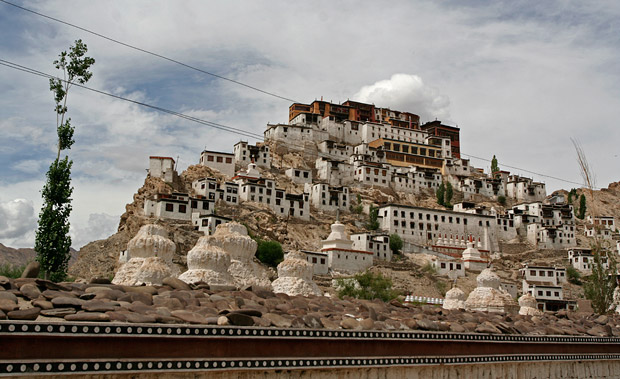
Yet, lama Sherap did not seem annoyed. He did not even blink at the photographer or showed the slightest discomfort. He simply continued at his work and once in a while looked up and smiled. He wasn’t perturbed even when the smile did not result in a reciprocation. After the mean photographer left without saying a ‘thank you,’ he looked at me and smiled as if telling me not to bother. I was sitting there talking with lama Sherap for a while and was very annoyed by the photographer’s behaviour. But the lama himself seemed to live up to what they learn – he was perfectly composed and simply resumed his work as though nothing happened.
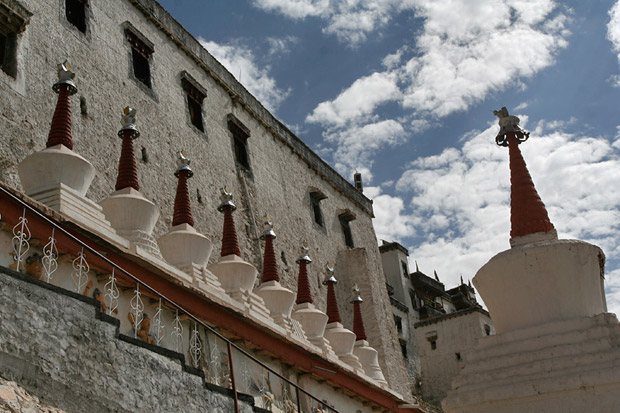
Lama Sherap was taking care of the du-khang that day. He was alone in the prayer hall as his companions had gone to the village to perform some rituals. He was friendly, approachable and smiled gently every time he spoke. Sitting on the floor close to the entrance of the hall, he busied himself kneading chunks of tsampa (barley flour) and preparing torma. He explained me what torma is and helpfully added that it is for some special prayers being performed tomorrow.
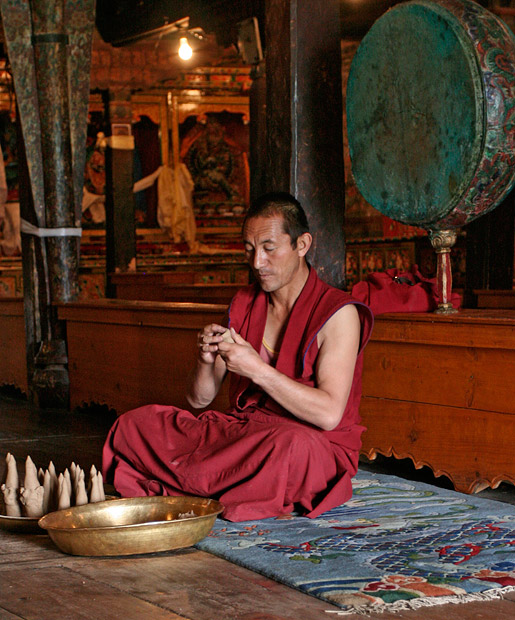
As I sat and talked to with him, a Ladakhi woman walked in, greeted the lama with a smile and a ‘julley’, prostrated repeatedly towards the altar and and left as quickly as she came. Tourists kept coming in packs, took pictures and left within minutes, having ticked Thiksey off their list. After the nosy photographer completed his work, lama Sherap asked me how a digital camera works.
‘Today’s cameras don’t have film rolls and you can see the pictures at the back of them,’ he said, ‘where do the photos get recorded?’ I took out the CF card from my camera and showed him in answer. His next questions came immediately.
“How may photos get stored on them? They could get 36 in a roll of film. In which country do they make these things?”
After satisfying his curiosity, it was my turn to ask questions. Lama Sherap showed me a statue of Tson-ka-pa, helpfully identified it for me and explained that the monastery belongs to Gelugpa order. ‘There are about a hundred lamas,’ he said, ‘some are young lads and some are more than forty years old.’
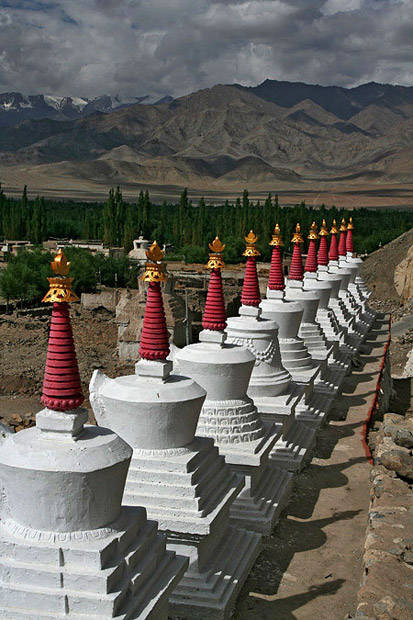
As long as I was with him, he never saw his smile go away. When tourists misbehaved, sitting on the carpets that were meant only for lamas, he would wait to see if they would rise soon and then offer them another seat. There was not the slightest hint of irritation or anger despite repeated violation of regulations by visitors. Later at chon-kor, the room with a large idol of Buddha Maitreya, I saw a visitor stumble and drop a lamp on the floor and guiltily look at the monk taking care of the room, only to see him smiling. What could be an embarrassing moment was instantly dissolved in those smiles.
The chon-kor has an impressive 2-storey high statue of Buddha Maitreya. The tall Maitreya sits in padamasana (lotus position) and has a calm unblemished face. His lotus-like crown is embellished with images of reincarnations of Buddha. His large ornate ear rings complement the crown and stand out against the turquoise outfit.
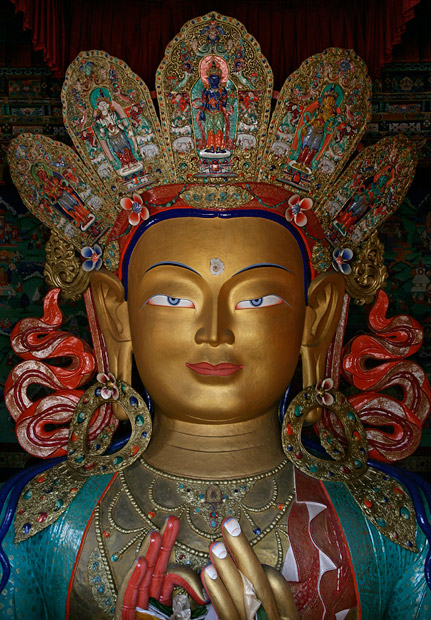
The Maitreya statue is relatively new, inaugurated in 1980 by Dalai Lama. The monastery itself was founded in early 15th century. Walking up the crag where a group of haphazardly built buildings of the monastery are located, it is evident that the institution has grown and expanded over the years. I climb up the steps leading to the monastery past a latest addition – a newly built row of chortens.
Inside, the du-khang seems to be old enough to be one of the first buildings built. To each side of its entrance are the colourful murals of the deities of the four directions, while inside walls are painted with various forms of Buddha and Yab Yum. At the rear side of du-khang is a small chapel with metallic statues of Tson-ka-pa and Manjushri.
The paintings on the outer walls have a curious diversion from tradition. The samsara-chakra has figures wielding guns and wearing clothes more suited for British and Indian men of the plains a few hundred years ago.
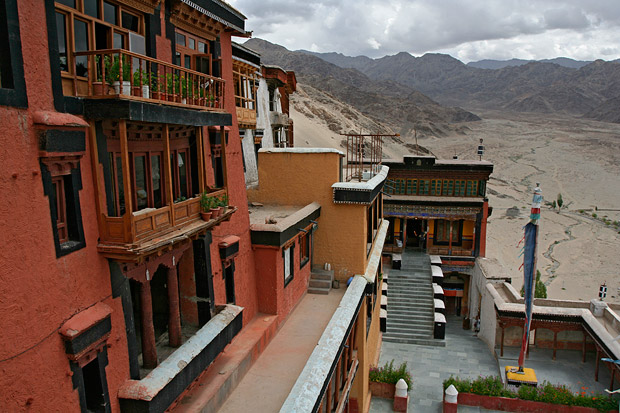
The stairs next to the du-khang lead to the terrace from where I can see the barley fields spread along the valley, the river coiling through the fields and the mountains beyond. In the corner of the terrace is a small room – a library filled with ancient Tibetan scriptures. As I descend from the stairs and head out to the valley, it is the smiles of Lama Sherap and the calm face of Maitreya that stay in my memory, etched stronger than the photographs I clicked in the monastery.
Continuing my series of stories on Ladakh, I will be writing in upcoming posts about monasteries that I visited. It would be useful to know a few terms often associated with Ladakhi Buddhism and Tibetan iconography before reading them. I will be using these terms very often in the posts about monasteries. More terms may be added as necessary. Come back to this post for references where needed.
Avalokitesvara. The Buddha of compassion with thousand arms to help the sentient beings.
Chorten. A Chorten or a Stupa is a holy structure with three parts – a square bottom, a circular middle section and a thin cylindrical top portion. On the top of it will be a crescent moon and a disc. Chortens are installed on the approach to monasteries and outside the village. They are meant to ward off evil.
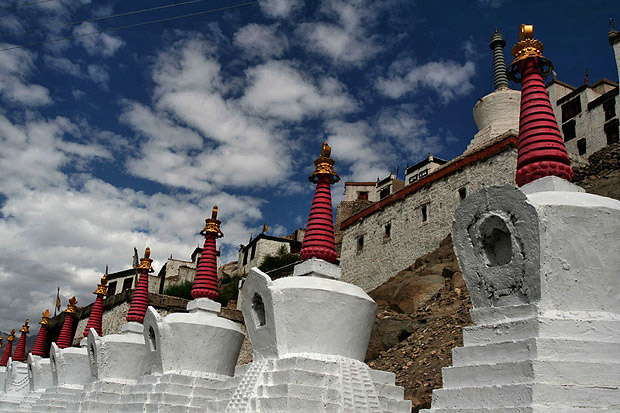
A series of Chortens.
Drukpa. A sect of Tibetan Buddhism, also referred to as Red Hat. The monasteries in Lamayuru and Hemis are among the prominent monasteries of this sect.
du-khang. The prayer hall of the monastery, often with richly decorated interiors and murals along the walls.
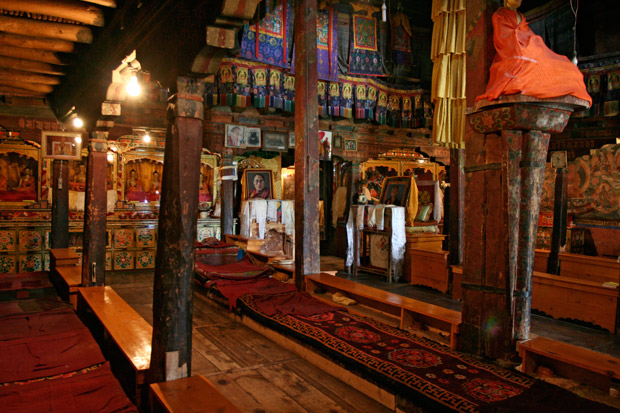
The du-khang in a monastery in Ladakh
Gelugpa. A sect of Tibetan Buddhism, also referred to as Yellow Hat. The monks of Gelugpa sect wear a tall yellow hat during special ceremonies and festivals. Most monasteries in Ladakh belong to this sect. Dalai Lama belongs to Gelugpa order.
Gompa. Ladakhi term for a monastery. Celibate monks (lama) live here and study the religious scriptures and meditation. Usually every village will have a gompa on a crag overlooking the entire village. Villagers use religious services of lamas from the monastery and often donate in cash or kind in return.
gon-khang. Gon-Khang or the room of guardian deities is a place of worship in the monastery that houses many demonic figures. Sometimes the deities are veiled. Some monasteries do not permit women inside gon-khang.
Mani wall. A thick wall built by loosely bound stones, often seen along the roads in a Ladakhi village. The stones will have ‘Om Mani Padmeham’ or other Tibetan mantras inscribed on them. One must always walk keeping the Mani wall to the right.
Manjushri. Manjushri is a Bodhisattva (emanating enlightened being) associated with awareness.
Tara. A female deity. Tara is usually painted in prayer halls as Green Tara or White Tara.

A statue of Tara
Torma. A material for worship made by kneading tsampa(barley flour) in to conical shape and decorated with Yak butter and other materials.
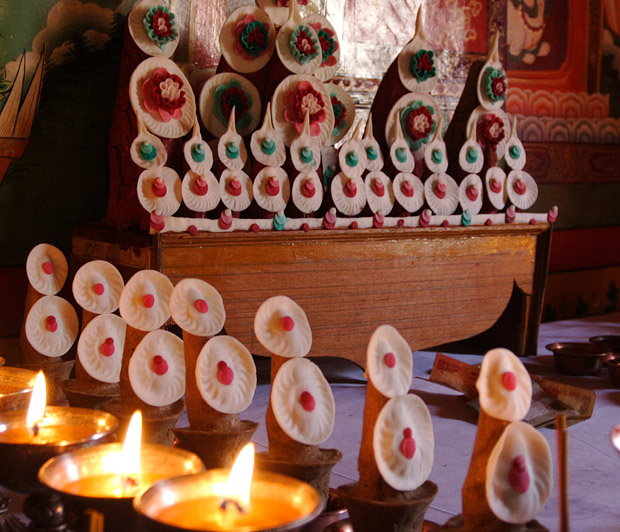
Tson-ka-pa. The lama who founded of Gelugpa sect. His statues and paintings can be seen in many monasteries that belong to Gelugpa sect.
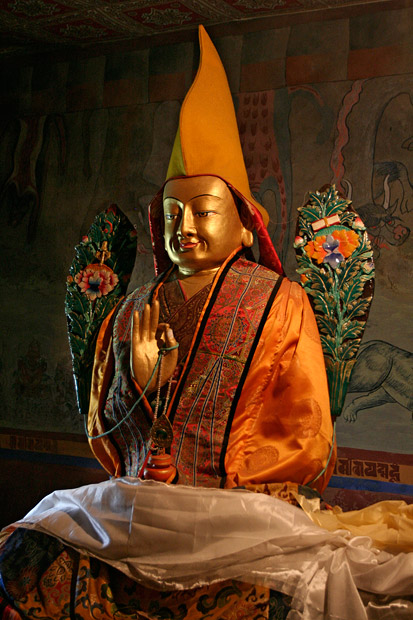
A statue of Tsonkapa
Wheel of Life. A complex painting often seen on the walls of monasteries, representing various levels of life according to Tibetan Buddhism.
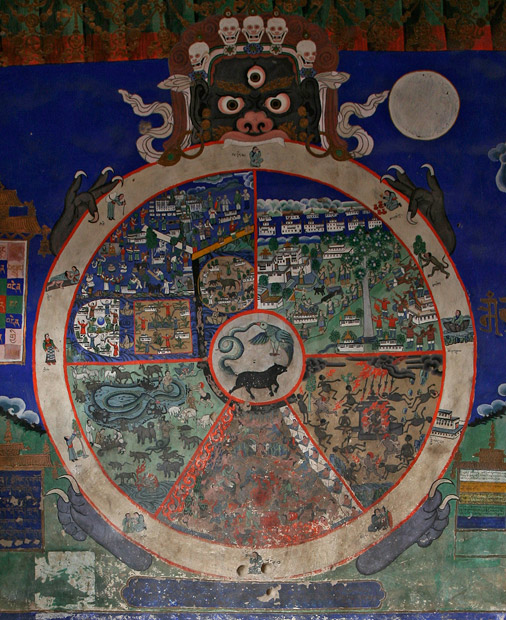
Yab Yum. A Tibetan Buddhist deity with multiple hands, always portrayed in union with a female deity. Paintings of Yab Yum can be seen in the prayer halls of the monasteries.
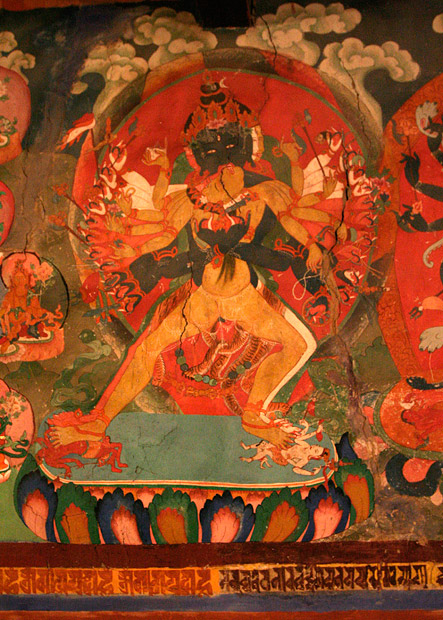
The tour is now sold out. Thank you all for the overwhelming response. Stay tuned for the next dates, or do send me an email at arunchs a-t yahoo d-o-t com, if you would like to be informed of the next schedules
Regular visitors here would know of the guided tour that Lakshmi and I have been planning. It is about visiting the less known, but charming places that were built by the thousand year old Hoysala Kings. Besides the guided visits, the participants will learn about the history and know about the origin, evolution and collapse of the Kingdom. After a very successful beta trip that received great response, we are now kicking off the tour. The next departure is on the weekend of July 4th. Details of the tour below. Please email me at arunchs a-t yahoo d-o-t com or call Arun/Lakshmi at 9880006460/9902070689 to register for the tour, or for any questions. Look forward to seeing you travel with us!
Tour – The Less Known Hoysala Kingdom
From Bangalore – July 4th 2009, 6.30am
Do you long for the feel of the rain brushing against you? Do you relish being out when it rains? And would you enjoy a dose of history to go with the freshness of the monsoon?
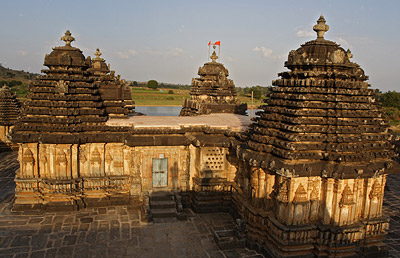
Then come and join us for the rainy-season edition of the tour of ‘Less Known Hoysala Kingdom’. We are heading to the fringes of Malnad. See the only Hoysala Temple that has not one but four shrines. Visit the beautiful tank with small shrines all around the water, surrounded by coconut trees in a quiet village. See the remains of the ancient town of Dwarasamudra strewn with carved rocks in a large open space.
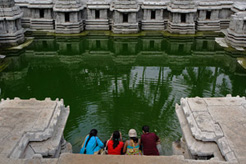
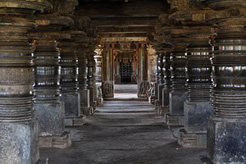
Join us on the trip to see the heritage of Hoysalas beyond the tourist map. Learn about the history, evolution and end of the dynasty as you travel.
In addition, stay in the verdant surroundings of a coffee estate. Spend a pleasant morning in the countryside before continuing on another serving of history.
Tariff
* 2 days and 1 night
* Rs.3,850 per person, all inclusive on twin sharing basis
Tariff includes all meals, transportation from Bangalore in AC vehicle, stay at a spacious and comfortable resort inside a coffee estate and guided tour at all destinations.
To register for the tour contact
Lakshmi – 9902070689
Arun – 9880006460
Email: arunchs a-t yahoo d-o-t com
Itinerary
* Pickup from MG Road on Saturday morning at 6.30am
* Stay at a resort near Belur
* Return to Bangalore by Sunday night (Drop off at home)
Places Covered
* The temple with four shrines at Doddagaddavelli
* Belur
* Halebeedu
* Ancient town of Dwarasamudra spread around Halebeedu
* Hulikere Tank
* Belavadi Temple
Testimonials from participants
* “very informative, and a wonderful experience… “
* “The places chosen to visit were too good. I have been there several times before but had seen only the main temples both at belur and Halebeed.”
* “the trip was fantastic”
* “Didnt have to bother about anything. Everything was taken care of well”
The Resort



















